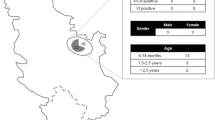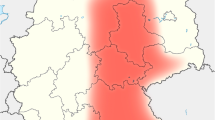Summary
In a long-term study, a total of 1,112 European wild boar (Sus scrofa) shot in the southern part of North Rhine Westphalia between 1993 and 2000 were investigated for the infection with pseudorabies virus (PRV). Of 929 sera tested during the 7 year observation period -92 (9.4%) had PRV-specific antibodies with an overall seroprevalence in the south west of North Rhine Westphalia of 11.4%. A total of 473 tissues and 516 mucosal swabs collected between 1996 and 2000 from wild boar originating from those districts were tested for the presence of PRV using virus isolation in cell culture. In 2000, 4 viruses were isolated from the tonsils of piglets and juvenile wild boar shot in the district of Bonn, which were identified as type Ip PRV. When tonsils and lungs were additionally tested in a glycoprotein D-specific PCR, 14 (4.0%) and 2 (1.6%) were positive. Virus isolation and PCR results suggest that PRV might be mainly transmitted by wild boar piglets. The results also indicate that PRV-infections have been endemic in wild boar populations in the south west of North Rhine Westphalia for several years. Based on present knowledge, the area covered by this study appears to be part of a larger, coherent endemic area comprising wild boar populations in neighbouring regions of western Germany. Recently, PRV was eradicated in the domestic pigs in North Rhine Westphalia resulting in a recognition as an officially Aujesky's disease free region within the EU. As in other regions, so far, PRV infections in the wild boar population appear not to affect the domestic pig population.
Zusammenfassung
In einer Langzeitstudie wurden zwischen 1993 und 2000 insgesamt 1112 Stück Schwarzwild (Sus scrofa) aus dem südlichen Nordrhein Westfalen auf das Vorhandensein von Pseudorabiesvirus- (PRV) Infektionen untersucht. Von 929 Seren, die während des 7-jährigen Beobachtungszeitraumes getestet wurden, zeigten 92 (9,4%) PRV spezifische Antikörper. Die durchschnittliche Seroprävalenz in der Eifel lag bei 11,4%. In den Jagdjahren 1996 bis 2000 wurden 473 Gewebeproben (Tonsillen, Lungen) und 516 Tupferproben (Nasal-, Genitaltupfer) von Schwarzwild aus der Eifel zwecks Virusisolierung in der Zellkultur untersucht. In der Jagdsaison 1999/00 gelang die Isolierung von 4 Viren aus den Tonsillen von Frischlingen und überläufern aus dem Landkreis Bonn (Kottenforst), die anhand desBamHI DNA-Spaltmusters als Typ Ip-Pseudorabiesviren (PRV) identifiziert werden konnten. Die Zahl der PRV-positiven Tonsillen und Lungen erhöhte sich auf 14 (4,0%) bzw. 2 (1,6%) bei der Untersuchung der Gewebeproben in einer gD-spezifischen PCR. Virusisolierung und PCR lassen persistent infizierte Frischlinge als Hauptüberträger des PRV in Schwarzwildpopulationen vermuten. Die Ergebnisse deuten weiterhin auf ein mehrjähriges endemisches Infektionsgeschehen bei Schwarzwild im Südwesten Nordrhein Westfalens hin. Nach bisherigen Erkenntnissen scheint das Untersuchungsgebiet Teil eines gro\en zusammenhängenden, endemischen Gebietes darzustellen, welches Schwarzwildpopulationen aus Frankreich, Belgien und den südwestlichen Teilen Deutschlands umfasst. Jüngst wurde die Aujeszky'sche Krankheit (AK) in den Hausschweinebeständen Nordrhein Westfalens erfolgreich getilgt und die Anerkennung als offiziell AK-freie Region erteilt. Wie in anderen Regionen Deutschlands scheinen PRV-Infektionen beim Schwarzwild die Hausschweinepopulation nicht zu gefährden.
Résumé
Dans le cadre d'une étude de longue haleine, un total de 1.112 sangliers d'Europe (Sus scrofa), tirés dans la partie méridionale de la Nord-Rhénanie Westphalie entre 1993 et 2000, ont été examinés quant à l'infection par le virus pseudo-rabique (PRV). Parmi 929sera testés au cours des 7 années d'obser. vation, 92 (9.4 %) présentaient des anticorps spécifiques de la PRV avec une séro-prévalence globale de 11.4 % dans le Sud-Ouest de la Nord-Rhénanie Westphalie. Un total de 473 tissus (amygdales, poumons) et de 516 prélèvements de mucosités, collectés dans ces districts entre 1996 et 2000, ont été cocultivés en vue de mettre en évidence la présence du PRV. En 2000,4 virus ont été isolés dans les amygdales de marcassins et de yearlings tirés dans le district de Bonn et ont été identifiés comme étant du type Ip PRV. Lorsque des amygdales et des poumons furent testés de faÇon complémentaire dans un PCR gD spécifique, respectivement 14 (4.0%) et 2 (1.6%) se révélèrent positifs. L'isolation des virus et les résultats au PCR suggèrent que le PRV est essentiellement transmis par les marcassins. Les résultats montrent aussi que les infections de PRV ont été endémiques dans les populations sauvages du Sanglier du Sud-Ouest de la Nord-Rhénanie-Westphalie pendant de nombreuses années. De plus, il s'avère que l'aire couverte par cette étude correspond à la bordure Nord-Ouest d'une aire considérable et cohérente sur le plan endémique, comprenant les populations de sangliers sauvages de France, Belgique et des régions adjacentes de l'Allemagne de l'Ouest. Récemment, le PRV a été éradiqué des porcs domestiques de la Nord-Rhénanie-Westphalie. Une reconnaissance comme région déclarée officiellement indemne de la maladie d'Aujesky a été sollicitée auprès de l'Union européenne mais n'a pas encore été obtenue. A l'instar d'autres régions et jusqu à présent, les infections de PRV dans la population de sangliers ne semblent pas affecter le Porc domestique.
Similar content being viewed by others
References
Albina, E.;Mesplede, A.;Chenut, G.;le Potier, M. F.;Bourbao, G.;le Gal, S.;Leforban, Y., 2000: A serological survey on classical swine fever (CSF), Aujeszky's disease (AD) and porcine reproductive and respiratory syndrome (PRRS) virus infections in French wild boars from 1991 to 1998. Vet Microbiol77 (1–2): 43–57.
Bastian, S.;Buffereau, J.P.;le Drean, E.;Bind, J.L.;Müller, T.;Toma, B., 2000: La maladie d'Aujeszky en France en 1999. Epidemiologié et Santé Animale38, 109–114.
Blancou, J.;Barrat, J., 1984: Pathologie des ongules sauvage de France. Gibier Faune Sauvage4: 87–95.
Bitsch, V.;Eskildsen, M., 1982: Complement dependent neutralization of Aujeszky's disease virus by antibody. In Current Topics in Veterinary Medicine and Animal Science, vol. 17, G. Wittmann, and S.A. Hall (eds.), Martinus Nyhoff Publishers, Utrecht, Netherlands, pp. 227–236.
Briedermann, L., 1990: Schwarzwild. Berlin: VEB Deutscher Landwirtschaftsverlag.
Capua, I.;Fico, R.;Banks, M.;Tamba, M.;Calzetta, G., 1997: Isolation and characterisation of an Aujeszky's disease virus naturally infecting a wild boar (Sus scrofa). Vet Microbiol.55 (1–4): 141–6.
Cheung, A.K., 1995: Investigation of pseudorabies virus DNA and RNA in trigeminal ganglia and tonsil tissues of latently infected swine. Am J Vet Res56 (1): 45–50.
Commission decision 2003/130/EC of 26 February 2003 amending Decision 2001/618/EC to include the whole territory of Germany in the list of Member States and regions free of Aujeszky's disease and certain departments of France in the lists of Member States and regions free of this disease and regions where approved eradication programmes are in place. Official Journal L 052, 27/02/2003, 0009-0010.
Council Directive 64/432/EEC of 26 June 1964 on animal health problems affecting intra-Community trade in bovine animals and swine. Official Journal P 121, 29/07/1964, 1977–2012.
Corn, J.L., Swiderek, P.K.;Blackburn, B.O.;Erickson, G.A.;Thiermann, A.B.;Nettles, V.F., 1986: Survey of selected diseases in wild swine in Texas. Journal of the American Veterinary Medical Association189: 1029–1032.
Gortazar, C.;Vicente, J.;Fierro, Y;Leon, L.;Cubero, M.J.;Gonzalez, M., 2002: Natural Aujeszky's disease in a Spanish wild boar population. Ann N Y Acad Sci969: 210–2.
Hahn, E.C.;Pierce, S.K.;Gibbs, E.P.J., 1996: Characterization of Aujeszky's Disease Virus Isolates From Feral Swine. Proceedings of the 14th IPVS Congress, Bologna, Italy, July 7–10, 1996.
Hahn, E.C.;Page, G.R.;Hahn, P.S.;Gillis, K.D.;Romero, C.;Gibbs, E.P.J.C., 1997: Mechanisms of transmission of Aujeszky's disease virus originating from feral swine in the USA. Vet Microbiol55 (1–4), 123–130.
Heinritzi, K.;Aigner, K.;Erber, M.;Kersjes, C.;von Wangenheim, B., 1999: Brucellosis and Aujeszky's disease in a wild boar enclose. Case report. Tierärztl. Prax. Ausg. G Grosstiere Nutztiere27 (1): 41–6.
Landesdatenbank NRW, 2003: http://hrsibm.lds.nrw.
Lutz, W;Wurm, R., 1996: Serologische Untersuchungen zum Nachweis von Antikörpern gegen Viren des Seuchenhaften Spätaborts, der-Aujeszkyschen Krankheit, der Europäischen Schweinepest und Porzine Parvoviren beim Wildschwein (Sus scrofa, L., 1758) in Nordrhein-Westfalen. Zeitschr. Jagdwiss.42: 123–133.
McCaw, M.B.;Xu, J.;Correa, M.T., 1995: Survival of pseudorabies virus on swabs maintained under standard field sample shipping conditions. J Vet Diagn Invest7 (1): 56–9.
Müller, T., 2000: Aujeszky'sche Krankheit-Gefahr für den Jagdhund — Das aktuelle Interview. Jagdgebrauchshund5, 1–2.
Müller, T.;Teuffert, J.;Ziedler, K.;Possardt, C.;Kramer, M.;Staubach, C.;Conraths, F.J., 1998a: Pseudorabies in the European wild boar from eastern Germany. J Wildl Dis34 (2): 251–258.
Müller, T.;Klupp, B.;Zellmer, R.;Teuffert, J.;Ziedler, K.;Possardt, C.;Mewes, L.;Dresenkamp, B.;Conraths, F.J.;Mettenleiter, T.C., 1998b: Characterisation of pseudorabies virus isolated from wild boar (Sus scrofa). Vet Rec.143 (12): 337–40.
Müller, T.;Teuffert, J.;Zellmer, R.;Staubach, C.;Klupp, B.;Otte, J.;Conraths, F.J., 1997: Pseudorabies virus infections in the European wild boar — A po-tential danger for domestic pigs? Proceedings of the VIII. International Symposium of Veterinary Epidemiology and Economics, July 8–11, Paris, Epidem Sante Anim 31–32, 01.08 p.
Nettles, V.F.;Erickson, G.A., 1984: Pseudorabies in wild swine. Proceedings of the United States Animal Health Association88: 505–506.
Pirtle, E.C., Roelke, M.E.;Brady, J., 1989: Antibodies against pseudorabies virus in the serum of a Florida black bear cub. Journal of the American Veterinary Medical Association189: 1164.
Schang, L.M.;Osorio, F.A., 1993: A quantitative technique for the study of the latency of Aujeszky virus. Rev Sci Tech.12 (2): 505–21.
Sokal, F.J.;Rohlf, F.J., 1995: Biometry. 3rd edition., New York: W. H. Freeman and Company.
Statistisches Bundesamt, 2003: Wiesbaden. https://www-genesis.destatis.de
Romero, C.H.;Meade, P.;Santagata, J.;Gillis, K.;Lollis, G.;Hahn, E.C.;Gibbs, E.P.J., 1997. Genital infection and transmission of pseudorabies virus in feral swine in Florida, USA. Vet Microbiol55: 131–139.
van der Leek, M.L.;Becker, H.N.;Pirtle, E.C.;Humphrey, P.;Adams, C.L.;All, B.P.;Erickson, G.A.;Belden, R.C.;Frankenberger, W.B.;Gibbs, E.P.J., 1993: Prevalence of pseudorabies (Aujeszky's disease) virus antibodies in feral swine in Florida. J Wildl Dis29: 403–406.
Wheeler, J.G.;Osorio, F.A., 1991: Investigation of sites of pseudorabies virus latency using polymerase chain reaction. Am J Vet Res52 (11): 1799–803.
Willer, H., 1982: Praktische Stichprobenplanung. Jena: Gustav Fischer Verlag, Germany, 163 pp.
Wittmann, G.;Bauer, K.;Commichau, C.;Frost, J.W.;Glende, W.;Hentschke, J.;Koch, K.;Liebke, H.;Schawel, R.;Wernery, U., 1987: Untersuchungen zur Vereinheitlichung des Neutralisationstests zur Diagnose der Aujeszkyschen Krankheit. Tierärztl. Umsch.42 (1), 41–50.
Zupancic, Z.;Jukic, B.;Lojkic, M.;Cac, Z.;Jemersic, L.;Staresina, V., 2002: Prevalence of antibodies to classical swine fever, Aujeszky's disease, porcine reproductive and respiratory syndrome, and bovine viral diarrhoea viruses in wild boars in Croatia. J Vet Med B Infect Dis Vet Public Health.49 (5): 253–256.
Author information
Authors and Affiliations
Additional information
Eingesetzt wurde ein Druckkostenzuschuss der LöRF NRW, Dezernat Forschungsstelle für Jagdkunde, für dessen Gewährung verbindlich gedankt wird. - Die Schriftleitung
Rights and permissions
About this article
Cite this article
Lutz, W., Junghans, D., Schmitz, D. et al. A long-term survey of pseudorabies virus infections in European wild boar of western Germany. Zeitschrift für Jagdwissenschaft 49, 130–140 (2003). https://doi.org/10.1007/BF02190453
Received:
Accepted:
Issue Date:
DOI: https://doi.org/10.1007/BF02190453
Key words
- Aujeszky's disease virus
- epidemiology
- isolates
- pseudorabies virus
- seroprevalence
- Sus scrofa
- virus
- wild boar




